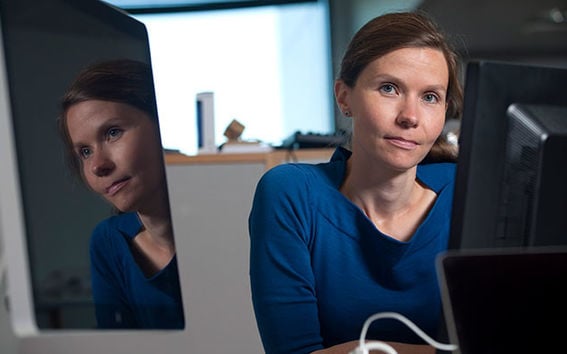Satellites provide information about Earth’s surface and the atmosphere

‘Remote sensing is the only way to observe changes everywhere on the Earth’s surface almost simultaneously. It is fascinating,’ Rautiainen says.
Personally, Rautiainen is interested particularly in vegetation. She examines the structure of vegetation on Earth, changes that take place in the vegetation and plant health on the basis of satellite images.
‘In Finland, remote sensing is used, for example, in forest inventory. We can find out details such as the height and density of a forest and the coverage of green biomass from the data.’
The equipment and methods used in remote sensing have developed very fast. For example, hyperspectral instruments that measure reflectance in different wavelengths of light have considerably increased the possibilities to apply remote sensing.
Hyperspectral imaging can be used to recognise plant species, detect plant diseases and estimate the sufficiency of nitrogen and other nutrients on cultivated land. Hyperspectral cameras attached to satellites and aeroplanes can be used to monitor, for example, oil leaks or other environmental catastrophes, rock types, minerals and ores.
In addition to vegetation and land use, remote sensing is also used to study oceans, glaciers and the atmosphere.
‘The material is used in studying climate change. Myself, I am in charge of a project that studies changes in the albedo of forests, in other words changes in their reflectivity. Reflectivity has an impact on what proportion of the Sun’s radiation remains on the Earth’s surface and warms it, and what proportion is reflected back into the space,’ says Rautiainen.
A national and international field
The professorship of remote sensing has been split between the School of Engineering and the School of Electrical Engineering. Rautiainen teaches in the master’s programmes in both schools.
‘I teach the physical properties of remote sensing and the use of Earth observation data in environmental monitoring to students in both master’s programmes from slightly different perspectives. ‘
Remote sensing is a part of the discipline of geoinformatics at Aalto University. Its research topics include for example modelling and management of spatial data, visual planning and production of maps as well as geodetic surveying. The field also includes interpretation of satellite and aerial images, laser scanning and 3D modelling.
According to Rautiainen, the employment situation in the field of remote sensing is good. Work is available internationally in large organisations such as the UN. Space organisations provide work for experts specialised in both satellite instruments and data applications. In Finland, especially the public sector and research institutes employ people in this field.
Contact information:
Professor Miina Rautianen
[email protected]
Read more news

Get to know us: Associate Professor Maria Sammalkorpi
Sammalkorpi received her doctorate from Helsinki University of Technology 2004. After her defence, she has worked as a researcher at the Universities of Princeton, Yale and Aalto.
Aalto computer scientists in ICML 2024
Computer scientists in ICML 2024
Getting bacteria into line
Physicists use magnetic fields to manipulate bacterial behaviour